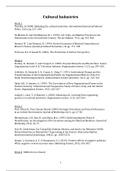Cultural Industries
Week 1
Throsby, D (2008). Modeling the cultural industries. International Journal of Cultural
Policy, 14(3), pp. 217–232.
De Marchi, N. and Van Miegroet, H. J. (1994). Art, Value, and Market Practices in the
Netherlands in the Seventeenth Century. The Art Bulletin, 76(3), pp. 451-464.
Baumol, W. J. and Baumol, H. (1994). On the Economics of Musical Composition in
Mozart’s Vienna. Journal of Cultural Economics, 18, pp. 171-198.
Peterson, R.A. & Anand N. (2004). The Production of Culture Perspective.
Week 2
Starkey, K., Barnatt, C. and Tempest, S. (2000). Beyond Networks and Hierarchies: Latent
Organizations in the U.K. Television Industry. Organization Science, 11(3), pp. 299-305.
Leblebici, H., Salancik, G. R., Copay, A. , King, T. (1991). Institutional Change and the
Transformation of Interorganizational Fields: An Organizational History of the U.S.
Radio Broadcasting Industry. Administrative Science Quarterly, 36(3), pp. 333-363.
Djelic, M.L. & Ainamo, A. (1999). The Coevolution of New Organizational Forms in the
Fashion Industry: A Historical and Comparative Study of France, Italy, and the United
States. Organization Science, 10(5), 622-637.
Lampel, J., Lant, T., & Shamsie, J. (2000). Balancing act: Learning from organizing
practices in cultural industries. Organization science, 11(3), 263-269.
Week 3
Voss, Glenn B.; Voss, Zannie Giraud (2000) Strategic Orientation and Firm Performance
in an Artistic Environment. Journal of Marketing, 64(1), pp. 67-83.
Bhattacharya, C.B., Rao, H. and Glynn, M.A. (1995) Understanding the Bond of
Identification: An Investigation of Its Correlates among Art Museum Members. Journal of
Marketing, 59(4), 46-57.
Ezra W. Zuckerman, Tai-Toung Kim, Kalinda Ukanwa, and James von Rittmann (2003).
Robust Identities or Nonentities? Typecasting in the Feature-Film Labor Market.
American Journal of Sociology, 108(5), pp. 1018-1074.
Berger, J., Sorensen, A. T., & Rasmussen, S. J. (2010). Positive effects of negative publicity:
When negative reviews increase sales. Marketing Science, 29(5), 815-827.
Week 4 : Midterm (no classes)
1
,Week 5
Papies, D., & van Heerde, H. J. (2017). The Dynamic Interplay between Recorded Music
and Live Concerts: The Role of Piracy, Unbundling and Artist Characteristics. Journal of
Marketing.
Elberse, A.(2008). Should You Invest in the Long Tail? Harvard Business Review, 86, nos.
7/8, pp. 88–96.
Salganik, M. J. and Watts, D.J. (2009) Web-based Experiments for the Study of Collective
Social Dynamics in Cultural Markets. Topics in Cognitive Science, 1, pp. 439-468.
Jenner, M. (2017). Binge-watching: Video-on-demand, quality TV and mainstreaming
fandom. International Journal of Cultural Studies, 20(3), 304-320.
Week 6
Crane, D. (1997). Globalization, Organization Size, and Innovation in the French Luxury
Fashion Industry: Production of Culture Theory Revisited. Poetics, 24, pp. 393-414.
Franssen, T., Kuipers, G. (2013). Coping with uncertainty, abundance and strife:
Decision- making processes of Dutch acquisition editors in the global market for
translations Poetics, 41, Pages 48-74.
Gemser, G.; Leenders, M.A.A.M and Wijnberg, N.M. (2008). Why some Awards are more
Effective Signals of Quality than Others: A study of Movie Awards, Journal of
Management, Vol. 34 No. 1,: 25-54.
Frank, E. & Nuesch, S. (2007). Avoiding ‘StarWars’ – Celebrity Creation as Media
Strategy. KYKLOS, 60(2), pp. 211–230.
Week 7
Footer, M. & Graber, C.B. (2000). Trade Liberalization and Cultural Policy. Journal of
International Economic Law, pp. 115-144.
Pathania-Jain, G. (2001). Global parents, local partners: A value-chain analysis of
collaborative strategies of media firms in India. The Journal of Media Economics, 14(3),
169-187.
Jin, Dal Yong (2007). Reinterpretation of Cultural Imperialism: Emerging Domestic
Market vs Continuing US Dominance. Media, Culture & Society, 29(5), pp. 753–771.
Burri, M. (2012). Cultural protectionism 2.0: Updating Cultural Policy Tools for the
Digital Age. In Transnational Culture In The Internet Age, Sean Pager and Adam Candeub,
eds., Edward Elgar Publishing, pp. 182-202
2
, Throsby, D (2008). Modeling the cultural industries.
Alternative definitions of the cultural industries lead to the construction of different
models of the cultural production sector of the economy and hence to a different array of
specific industries which are contained within the sector. In turn this implies not just
differing estimates of the contribution of the cultural industries to output and employment
in the economy but also significant differences in the way economic analysis can be applied
to the cultural sector as a whole. This paper begins by discussing the way in which an
economic approach to interpreting the scope of the creative and cultural industries can
lead to a reasonable basis for defining them. It then goes on to examine the content of six
distinct models of these industries, asking the question: is it possible to find a common core
group of industries on which all of the models agree? The paper then considers the
implications of the models for economic analysis of the cultural sector, and finishes with
some conclusions for cultural policy.
Article in a nutshell: The author discusses the definition of cultural industries, the
boundaries of cultural industries, and examines six tools for economic analysis that can be
applied to cultural industries
3




